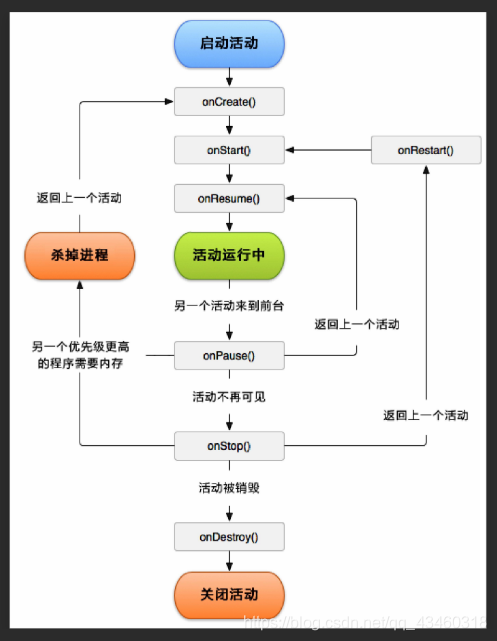一.活动的生命周期
1.活动状态
- 运行状态:一个活动处于返回栈的栈顶(系统最不愿意回收的活动,影响用户体验)
- 暂停状态:活动不处于栈顶,但仍然可见(系统不愿意回收的活动,影响用户体验,内存极低的情况会回收)
- 停止状态:活动不处于栈顶,并且完全不可见(系统会为活动保存相应的状态和成员变量,需要内存时会回收)
- 销毁状态:活动从返回栈移除后就变成了销毁状态(系统优先回收,保证手机内存充足)
2.活动的生存周期
Activity类中定义了7个回调方法,以覆盖活动生命周期的每一个环节。
- onCreate() 用于完成活动的初始化操作:加载布局,绑定事件等。
- onStart() 在活动由不可见变为可见的时候调用。
- onResume() 在活动准备和用户进行交互时调用。此时的活动一定处于返回栈的栈顶,并处于运行状态。
- onPause() 在系统准备启动或者恢复另外一个活动时调用。我们会用这个方法将一些消耗CPU的资源释放掉,同时保存一些关键数据,但是这个方法的执行速度一定要快,否则会影响到新的栈顶活动的使用。
- onStop() 在活动完全不可见时调用。如果启动的新活动是对话框式的活动,那么onPause()方法会得到执行。而onStop()方法不会执行。
- onDestroy() 在活动被销毁前调用,之后活动的状态会变为销毁状态。
- onRestart() 在活动由停止状态变为运行状态前调用,即活动被重新启动了。
活动的三种生存周期:
- 完整生存期:即活动在onCreate()方法和onDestroy()方法之间所经历的。一般情况下,活动会在onCreate()方法中完成初始化操作,在onDestroy()方法中完成释放内存的操作。
- 可见生存周期:即活动在onStart()方法和onStop()方法之间所经历的。通过这两个方法来管理对用户可见的资源。比如,在onStart()方法中加载资源,在onStop()方法释放资源,从而保证停止状态的活动不会占用太多的内存。
- 前台生存周期:即活动在onResume()方法和onPause()方法之间所经历的。在前台生存周期内,活动处于运行状态,活动可与用户进行交互。
活动的生命周期流程图:

二.示例了解活动的生命周期
新建ActivityLifeCycleTest项目,新建DialogActivity和DialogActivity。
编辑normal_layout.xml:
<LinearLayout xmlns:android="http://schemas.android.com/apk/res/android"
android:orientation="vertical"
android:layout_width="match_parent"
android:layout_height="match_parent">
<TextView
android:layout_width="match_parent"
android:layout_height="wrap_content"
android:text="This is normal activity"
/>
</LinearLayout>
编辑dialog_layout.xml:
<LinearLayout xmlns:android="http://schemas.android.com/apk/res/android"
android:orientation="vertical"
android:layout_width="match_parent"
android:layout_height="match_parent">
<TextView
android:layout_width="match_parent"
android:layout_height="wrap_content"
android:text="This is dialog activity"
/>
</LinearLayout>
修改AndroidManifest.xml的< activtiy >标签的设置:
<activity android:name=".NormalActivity" />
<!--
android:theme用来指定主题,@style/Theme.
AppCompat.Dialog用来让DialogActivtiy使用对话框式主题
-->
<activity android:name=".DialogActivity"
android:theme="@style/Theme.AppCompat.Dialog">
</activity>
修改activity_main.xml:
<LinearLayout xmlns:android="http://schemas.android.com/apk/res/android"
android:orientation="vertical"
android:layout_width="match_parent"
android:layout_height="match_parent"
>
<Button
android:id="@+id/start_normal_activtiy"
android:layout_width="match_parent"
android:layout_height="wrap_content"
android:text="Start NormalActivity"
/>
<Button
android:id="@+id/start_dialog_activtiy"
android:layout_width="match_parent"
android:layout_height="wrap_content"
android:text="Start DialogActivity"
/>
</LinearLayout>
修改MainActivtiy中的代码:
public class MainActivity extends AppCompatActivity {
public static final String TAG = "MainActivity";
@Override
protected void onCreate(Bundle savedInstanceState) {
super.onCreate(savedInstanceState);
Log.d(TAG,"onCreate");
setContentView(R.layout.activity_main);
final Button startNormalActivtiy = (Button) findViewById(R.id.start_normal_activtiy);
Button startDialogActivity = (Button) findViewById(R.id.start_dialog_activtiy);
startNormalActivtiy.setOnClickListener(new View.OnClickListener() {
@Override
public void onClick(View v) {
Intent intent = new Intent(MainActivity.this,NormalActivity.class);
startActivity(intent);
}
});
startDialogActivity.setOnClickListener(new View.OnClickListener() {
@Override
public void onClick(View v) {
Intent intent = new Intent(MainActivity.this,DialogActivity.class);
startActivity(intent);
}
});
}
protected void onStart(){
super.onStart();
Log.d(TAG,"onStart");
}
@Override
protected void onResume() {
super.onResume();
Log.d(TAG,"onResume");
}
@Override
protected void onStop() {
super.onStop();
Log.d(TAG,"onStop");
}
protected void onPause() {
super.onPause();
Log.d(TAG,"onPause");
}
protected void onDestroy() {
super.onDestroy();
Log.d(TAG,"onDestory");
}
protected void onRestart(){
super.onRestart();
Log.d(TAG,"onRestart");
}
}
最后根据操作的不同,在打印日志里面会看到不同的打印信息:


小结:对活动的生命周期有了模糊的概念,会在以后的学习中越来越明晰。
 理解Android活动生命周期
理解Android活动生命周期





















 被折叠的 条评论
为什么被折叠?
被折叠的 条评论
为什么被折叠?








